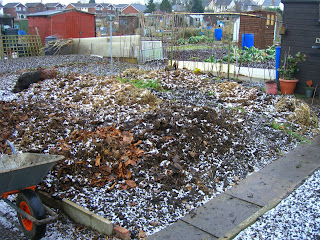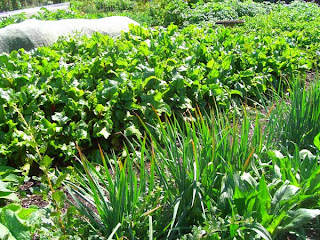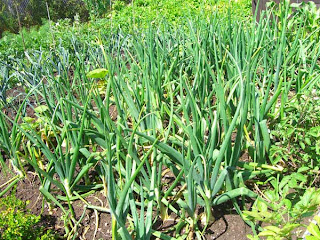The bloke with the shire horses brought two big loads of muck to the allotment today.
It does amaze me the way that people respond to the coming of the muck. It is free and first come first served. So as soon as it arrived people seemed to appear from nowhere with wheel barrows and forks to demolish the pile. I am not joking it went in 20 minutes. The second load came just when we had finished removing the first.
The shire horse bloke could not believe we had taken all of the first load but he was grateful because he wasn't sure where he was going to put the second load. Now he had plenty of space.
I took about 8 barrow loads down to the allotment and put some onto the compost heaps and the rest between the comfrey plants. I didn't really have anywhere else to put it because the allotment is fairly full with plants. I could have put some around the black currant bushes but I am using this space to get to the sweet peas so I was a bit reluctant to use it there.
It is fine where it is and the comfrey can convert it into liquid that I can use straight away rather than waiting for a year before I use it. I wouldn't wait a year anyway. Horse muck is not very high in nutrients and would not harm plants if you put it on fresh - in my experience.
Why people are so excited when the muck comes when it does not add a great deal to the soil baffles me. There are more nutrients in lawn mowings but a great heap of these are left in the bays for months.
Well, I was going to get some lawn mowings too but the compost bins are full to overflowing especially now there is muck in them. I will wait a bit until the composts go down before adding anything else. I took the green tarpaulin out of the store shed and put it over the compost heap to keep in the heat and the dampness.
This all began at 12 o'clock and beforehand I had done a few things.
I got out the spinach that had gone to seed next to the parsnips. I picked some so we will have that tonight but the rest I put on the compost heap. I replaced the spinach with chard.
I went around watering the vegetables primarily because of the competition tomorrow. If I get over 80 out of 183 then I will be very pleased. The best that our allotment site has achieved in the past is 110. I am not that bothered because it is a working allotment not a show one. If you are growing for eating rather than growing for showing then you have to accept that the allotment will not be pristine.
There is not much weed but that is because crops grow better when there is little competition. The rows are straight because it is easier to hoe between lines of vegetables. The veg is big because I want to maximise my yield. Hey, what can I say. The judging is the judging and I will accept any points gratefully, have a nice cup of tea and forget the whole affair.
Started to pick the peas today. I am getting a fair few off the rows but all the rows are coming at the same time. I will just freeze the excess I think. The same with the calabrese and the purple sprouting.
I took three of the turnips which were just over golf ball size. Not sure what I am going to do with them yet but probably they will be eaten raw in salad. These are the special turnips that are supposed to taste like melon. Well I can assure you that, regardless of the blurb on the seed packets, they don't taste anything like melons. They do, in fact, taste exactly like turnips. As you would expect BECAUSE THEY ARE TURNIPS.
I watered the French and the runner beans. I will have a lot of beans when they start fruiting. I still have a lot of broad beans to crop yet so the freezer is going to be chocker block. Better that than full of fast food ballast.
The sweet peas look really good now and a little cosmetic side shooting and detendrilling made them look even better. Hoed between the rows just to make them look pristine. Then went to sweep the paths. I know, I know, I would never have bothered if it was not for the competition but it is the detail that makes the difference.
It probably isn't what makes the difference and what does is how good you are at growing vegetables so either way I might get some more points for tidiness because I sure wont get very many points for growing.
Started picking the black berries from this really early fruiting bush I have. I would estimate about two hundred grams of berries which is better than a poke in the eye with a sharp stick with nails in it. Which is what nearly happened to me today.
Except that it was not particularly sharp and there were no noticeable nails sticking out.
That is all by the bye and due to the hot, close weather I was getting a little parched which means in allotment speak, it is time for a good cup of tea. Not to mention chocolate biscuits. Now I did feel a bit guilty about only having chocolate biscuits so I went to see if there were any raspberries. I found five measly ripe raspberries, although thinking about it logically I did take off about 3 kilos of berries yesterday.
According to Tesco, raspberries are £16 a kilo so I bought home £48 worth of raspberries.
When, honestly, would you go out and buy £48 worth of raspberries?
Allotments are great if you like raspberries.
So that is why there were only five measly raspberries today. I carefully put them with the black berries and we will probably have them in a pie.
I was going to leave the lupins to go to seed but I noticed that the seed heads were covered in greenfly. Needless to say they were quickly taken off and put onto the compost heap under the tarpaulin.
It was time to go home but I had a wander around the allotment just to see how everyone else was doing. Then home and a nice cup of tea.










































